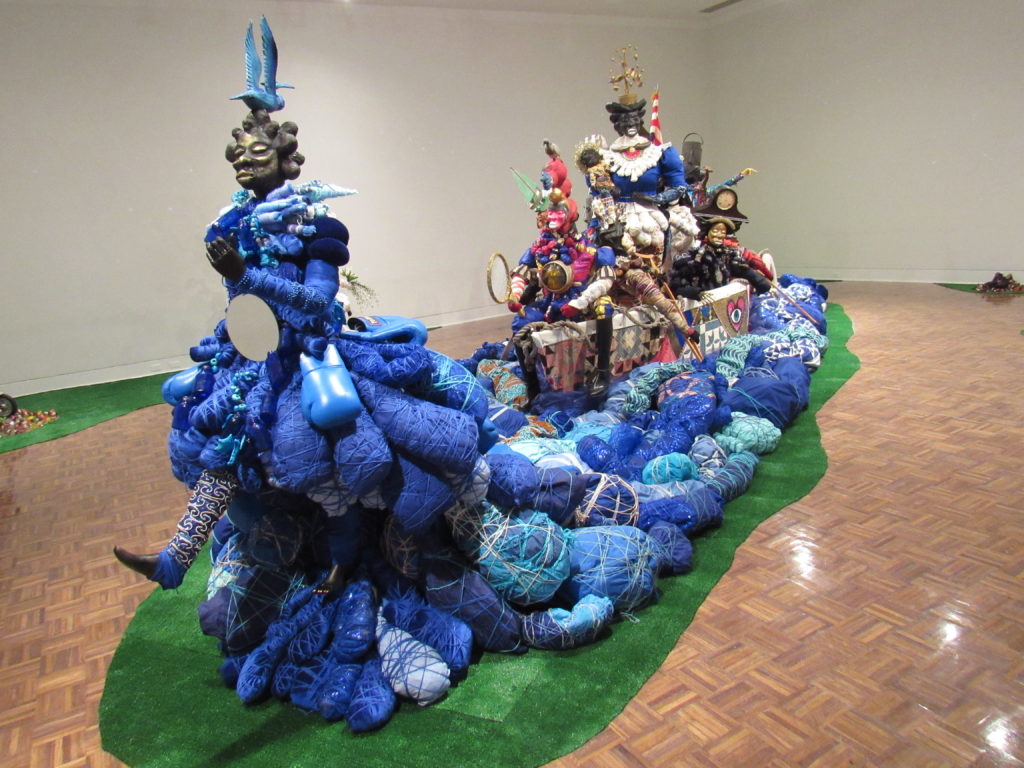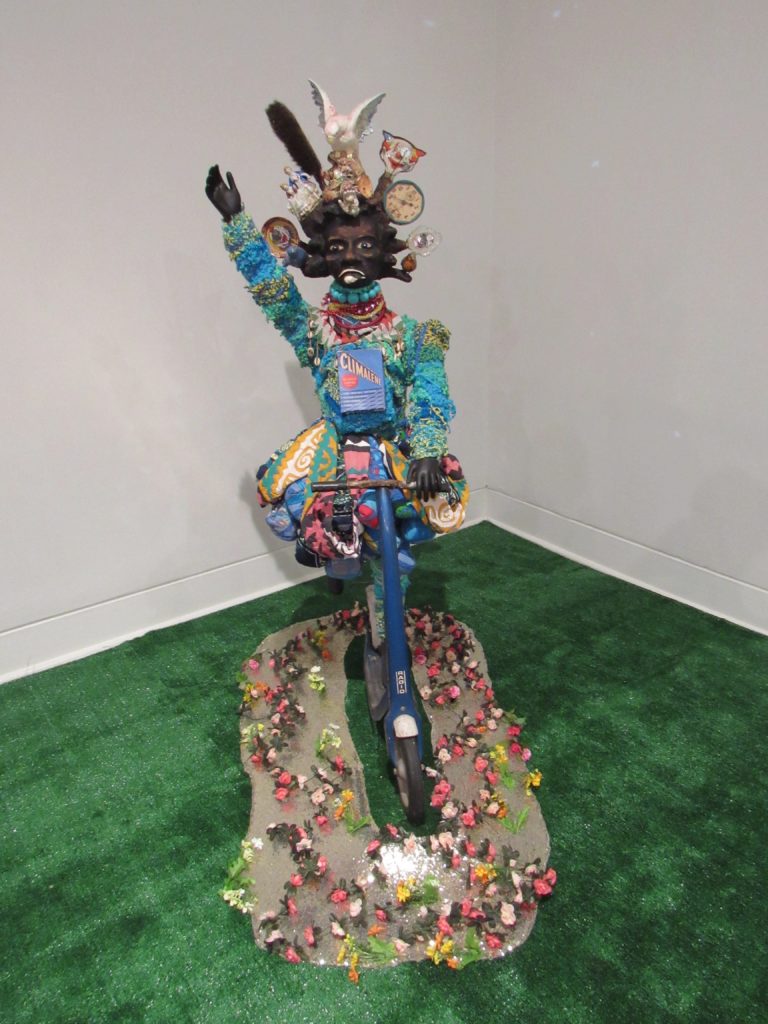
Vanessa German (Photo provided by Flint Institute of Arts)
By Harold C. Ford
Editor’s Note: EVM staff writer Harold C. Ford also is a provisional docent at the Flint Institute of Arts (FIA) and was present in a dual capacity during a walk-through of Vanessa German’s new exhibit at the FIA Jan. 25. Miracles and Glory Abound opened to the general public Jan. 27.
“The future belongs to the human beings who have the creativity and the courage to live inside the truth.” …Vanessa German, 2017
Vanessa German discovered the transforming power of art when she escaped a particularly dreadful phase of her life by collecting things as she walked her dog to find relief from the gloom.
“I would pick up little objects and things from vacant lots, from around abandoned houses in my neighborhood,” she told a Pittsburgh audience in 2017.
She took the objects—shards of glass, buttons, cans, swatches of fabric, glass bottles, scraps of paper—to the basement of her Pittsburgh home and put them together to create works of art.
“A shard of glass looks worthless,”said German. “But when you put those shards together you can create an entirely new picture.”
“I found that when I was in the process of creating these figures something happened to me. Something came over me so holy, and truly, and completely, that I was changed by the process…I could contend with the despair.”
Artistic style rooted in childhood
Creativity was bred into her during her childhood as the middle child of five siblings raised in Los Angeles in the 1980s and 1990s.
“I was really influenced by my mom (a quilter) who basically kept us safe and kept us alive by keeping us in the house,” German said. “She would make us make stuff. She would put art supplies all over the table and we would have to make our own lives.”
“We made our own clothes, toys, books, recordings, plays,”she recalled. “So I really grew up my whole life understanding that I did not have to outsource my own fun (or) creativity. I could make the things of my life.”
“I never experienced the great music or arts school,”she said. “I always felt like I was an artist and could always do whatever I wanted to do.”
Assemblage art
According to Hilary Robinson, professor of feminism, art, and theory at England’s Loughborough University, German’s style, dubbed “assemblage art” by the art community, is “part of an aesthetic tradition that has a strong thread within art by African American artists.”
Robinson’s comments are contained in an new 63-page book, Miracles and Glory Abound, produced by the FIA and meant to complement the exhibit of the same name.
Many assemblage artists, according to Robinson, “have marginalized cultural and political identities, or (are) from sexualities that have been regarded as deviant and criminalized.” Thus, Robinson continues, “the strength of assemblage as a mode of art-making amongst African American artists is striking.”
John Henry, FIA executive director, explained in the foreword to the companion book that he saw German’s work at the Pavel Zoubok Gallery in New York City in 2016. “I knew at that moment that not only did a work of hers need to be in the FIA permanent collection, but that such an assembly of sculptures would make for a fantastic exhibition.”
Prior to installation of the current exhibit, German conducted workshops with young people at the Berston Field House, the Boys and Girls Club, and in the Flint Cultural Center in July 2018. On the weekend of the exhibition opening, she visited with students and educators at Mott Community College and the Flint Public Library.
Miracles and Glory Abound

Miracles and Glory Abound, Vanessa German (2018)
The centerpiece of German’s FIA exhibit is a mixed-media installation titled Miracles and Glory Abound (2018), a life-sized representation of Washington Crossing the Delaware (1851), the iconic painting by Emanuel Leutze.
Leutze’s painting is a representation of a foundational story about the birth of America. It is the visual narrative of George Washington leading Continental soldiers across the Delaware River in 1776. German’s Miracles and Glory Abound challenges the Leutze narrative.
“Who gets to shape-shift that story?” German asked her FIA audience. “Who gets to create the images for those stories of American greatness?”
German’s take on the Leutze painting is reminiscent of Robert Colescott’s painting, George Washington Carver Crossing the Delaware: Page from an American History Textbook (1975), in that all the human figures are obviously African American.
“Miracles and Glory Abound with its boat full of figurative sculptures, functions as both a continuation of and a disruption of the canon,” according to Holly Bass, a writer and performance artist.
“She (German) inserts and asserts her Blackness, her womanness, her multivalent queerness, into this ongoing American narrative and asks us to consider the birth of this nation, a mythology of chopped cherry trees and founding fathers lying through wooden teeth.”
“The political meets the spiritual meets the cultural,” German said of Miracles and Glory Abound. “They meet in a way of my understanding of rightness.”
Power, color, intention
German’s artwork frequently includes female figures that she calls “power figures.” Pittsburgh Post-Gazette writer Diana Nelson Jones described them in this way:
“Festooned with buttons, beads, shells, toys and other objects, each is a personified experience, the persona centered in a head painted black with objects on top of it or shooting from it.”
In addition to those assembled aboard the boat on Miracles and Glory Abound, German’s “power figures”are ever present in the artist’s other pieces chosen for the FIA exhibit including: oh for the healing of the blues(2016); imagine then, seeing your own face, outside of your own face, for the very first time (2018); and we are the animals are us (2017).

“oh for the healing of the blues” (2016) Vanessa German (Photo by Harold C. Ford)
“This is my neighborhood,” German said of her artistic personages during the FIA walk-through. “I created a family that is looking.”
The color palette of German’s neighborhood is dominated by red, white, black, blue, and gold. Colors, as well as objects, are the lexicon that guide her collection of objects that may become incorporated into her art.
“There are other colors too,” Bass writes,“…yellow, pink, bits of orange and green, the faceted brown-black of African masks and dark skin.”
“Everything is intentional,” German said. “You’ll always see birds because birds, in my lexicon, stand for true liberty…Everything means something.”
African inspiration:
Discerning makers of art familiar with German’s work detect a style inspired by Africa. Artist and poet Daniel Simmons writes:
“German’s works are that of a modern magical diviner, drawing power from accumulated objects from personal history, community, and the society in which she resides and creates. Like the traditional makers of nkisi, who used various materials available to them, such as bones, nails, pieces of mirrors, and herbal potions to infuse magic into the objects…”
Nkisi are spirits, or an object that a spirit inhabits. The term is frequently applied to objects found in the Congo Basin in Central Africa.
German’s Flint connectedness:
German may feel kinship with a city whose public perception is that of a beleaguered urban center wracked by crime, poverty, and infrastructure failures. Homewood, her adopted neighborhood in easternmost Pittsburgh, was described as “the most dangerous neighborhood in America”by MSNBC journalist Rachel Maddow.
Reminding her audience that she is a native of Pennsylvania “fracking country,”she said she understands the importance of clean, safe, drinking water. “We have to think politically about water,”she said during her visit to the FIA. She stood with Native Americans at the Standing Rock Indian Reservation to oppose the construction of oil pipelines under natural waterways.
Humanness is likely the only commonality that German needs to find connectedness. She told a 2017 audience: “We are earthling siblings, gravity-bound, oxygen-breathing, creatures of carbon star-shine, and dust. We are 99 to 99.9 percent genetically identical.”
* * * *
The Vanessa German exhibit, Miracles and Glory Abound, is at the Flint Institute of Arts through April 20. A companion exhibit, Engaging African Art: Highlights from the Horn Collection, runs through May 26. It features artworks from the Dr. Robert Horn collection drawn from more than 60 African cultures.
Banner: “we are animals are us” (2017) Vanessa German (Photo by Harold C. Ford)
EVM Staff Writer Harold C. Ford can be reached at hcford1185@gmail.com.


You must be logged in to post a comment.